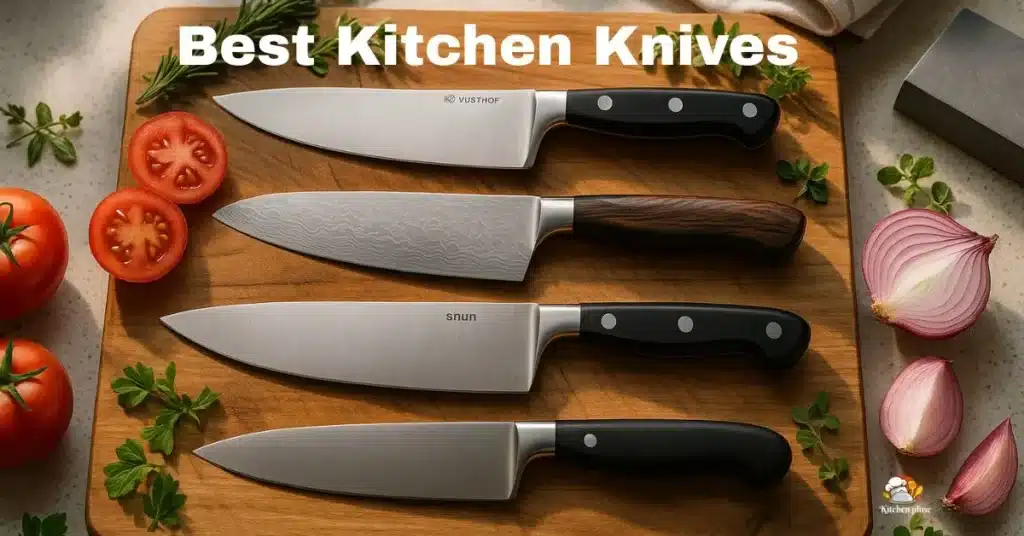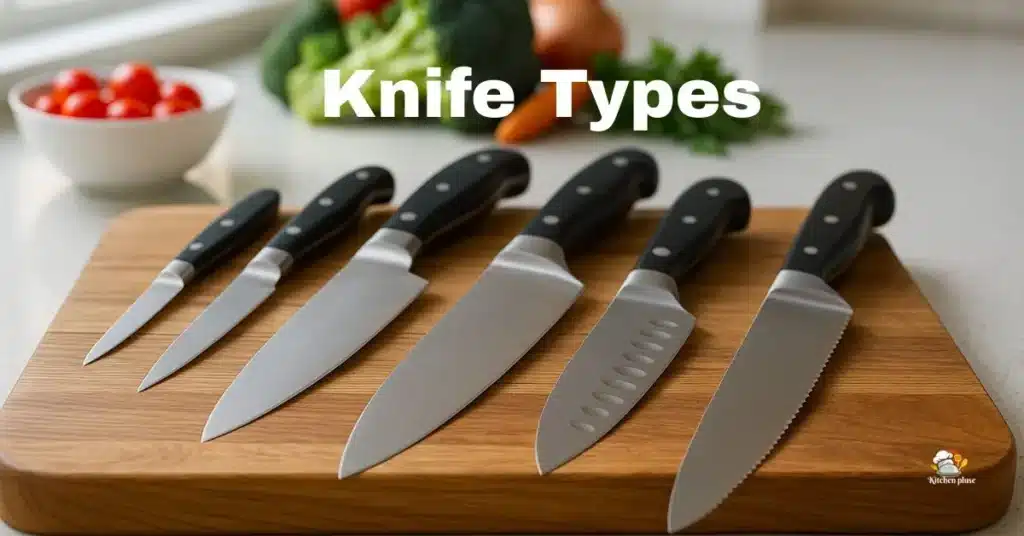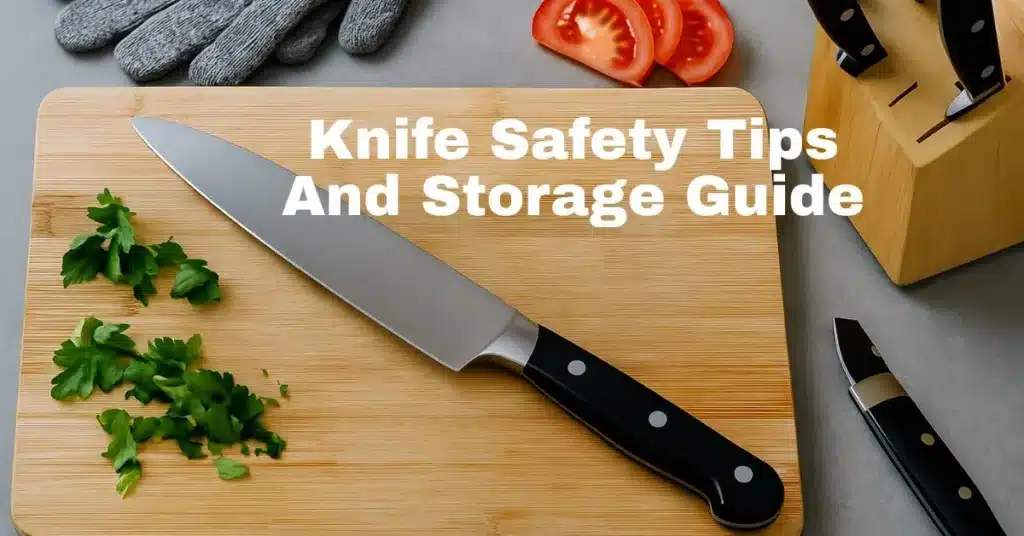From samurai precision to European power, knives show how two great cultures mastered the same art in different ways.
Japanese knives, born from the sword-making craft of Seki City, focus on balance, purity, and razor-sharp control.They are light, slim, and shaped for smooth, clean cuts.
Western knives, forged for centuries in Solingen, Germany, focus on strength, weight, and lasting toughness.They are heavier, thicker, and built for everyday chopping power.
These two knife traditions now guide how modern kitchens—especially in the United States—slice, dice, and create meals.
To understand how this evolution began, history of kitchen knives see how knife design evolved from samurai blades to modern chef knives.
Two Styles at a Glance
| Feature | Japanese Knife | Western Knife |
| Blade style | Thin, single bevel | Thick, double bevel |
| Cutting motion | Straight push | Rocking chop |
| Feel | Light and precise | Solid and strong |
Japanese knives cut with precision. Western knives cut with power.
If you cook at home in California or work as a chef in Texas, knowing these contrasts helps you choose the knife that fits your kitchen routine and your cooking goals.
Next, we’ll break down how these cultural philosophies shaped the actual blade geometry and cutting style of Japanese and Western knives.
Blade Geometry & Design Differences
Blade geometry means how a knife’s edge is shaped — its bevel angle, spine thickness, and edge profile. If you want to learn about different edge shapes and how they affect cutting, check our guide on Knife Edge Types. These details decide how sharp, strong, and comfortable a knife feels while cutting food.
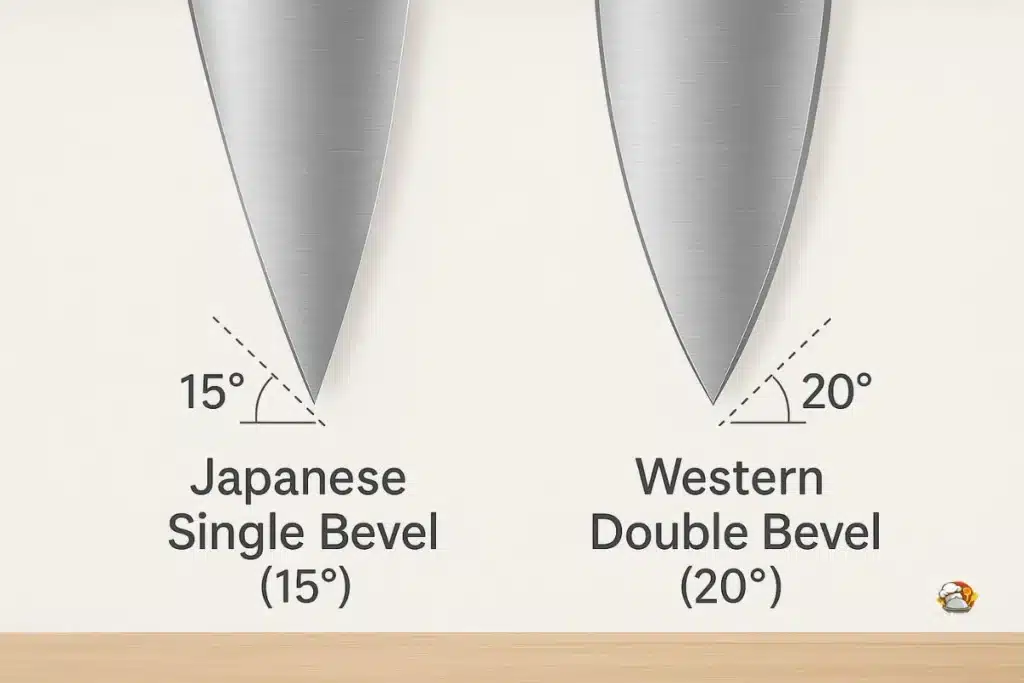
Japanese Knives
Japanese knives have a single bevel edge (about 15°) and a thin spine. This shape lets the blade glide smoothly through vegetables, herbs, and fish. They are made for precision and control, giving fine and clean slices with very little effort.
Western Knives
Western knives use a double bevel edge (about 20°) and a thicker spine for more strength. They are heavier and made for power and durability. This style works best for chopping meat or cutting dense foods.
How Blade Angles Affect Cutting
- A sharper, thinner edge (15°) cuts faster and cleaner but needs more care.
- A wider, thicker edge (20°) is stronger, lasts longer, and is easier to maintain.
| Feature | Japanese Knife | Western Knife |
| Bevel Angle | ~15° (Single) | ~20° (Double) |
| Spine | Thin (≈2 mm) | Thick (≈4 mm) |
| Bolster & Tang | Partial, lightweight | Full tang with bolster |
| Cutting Motion | Push cut | Rock chop |
| Best Use | Precise slicing | Heavy chopping |
Quick Definition
Blade geometry is the overall shape of a knife’s cutting edge.
A thin Japanese bevel makes finer cuts but needs more care.
A wider Western bevel gives a tougher, longer-lasting edge.
Why Does Blade Geometry Matter?
Because it affects how easily the knife slices and how long the edge stays sharp.Japanese blades focus on detail and speed, while Western blades offer stability and power.
For an expert comparison of how bevel angle impacts sharpness and control, read the detailed test results from America’s Test Kitchen.
In the next section, we’ll explore what lies beneath the shine — the steel itself — and how composition and hardness define a knife’s performance.
Steel Composition & Hardness
Knife steel composition is the mix of metals that decides how sharp, strong, and durable a knife can be. It also affects how long the edge stays sharp and how easy the knife is to maintain. To learn more about how different steels affect knife performance, see our guide on Knife Materials and Construction.
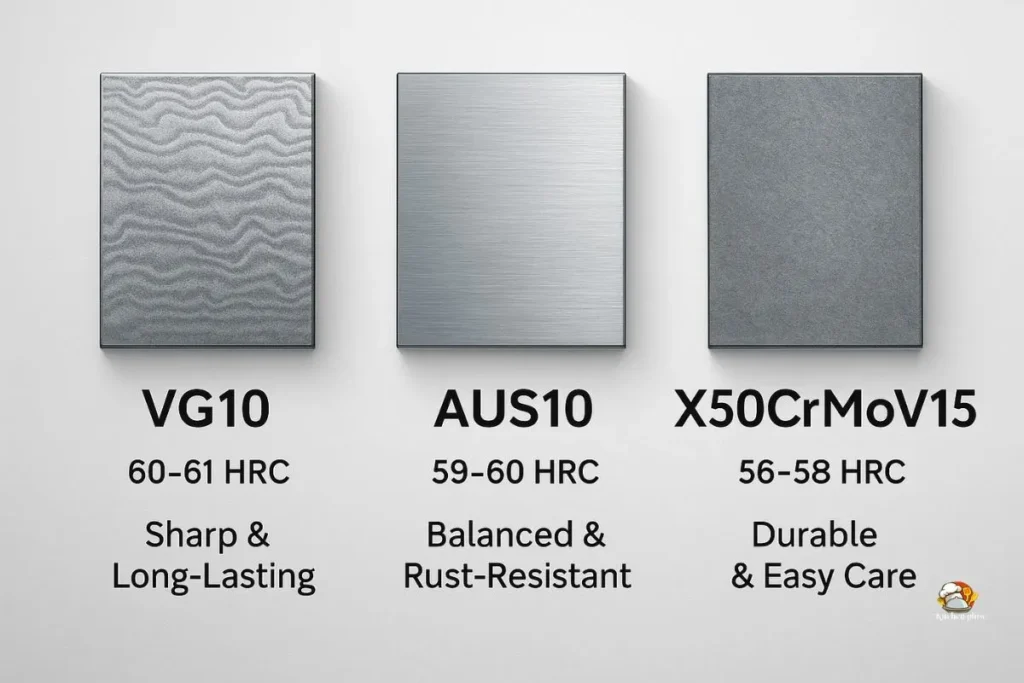
Japanese Knife Steel
Japanese knives are made from harder steel types like VG10, AUS10, and Blue Steel, which rate around 60–62 HRC on the Rockwell scale. See the Rockwell Hardness Scale reference for steel HRC ratings to understand how hardness levels affect edge retention and blade durability.
This higher hardness creates a razor-sharp edge and excellent edge retention, but the blades can chip if used with too much force. You can also compare these popular steels directly in our detailed breakdown — VG10 vs AUS10
- VG10 Steel: Stays sharp for a long time and gives clean, smooth cuts.
- AUS10 Steel: Rust-resistant, easy to sharpen, and well-balanced.
- Blue Steel: A high-carbon steel used in traditional Japanese blades; extremely sharp but needs more care.
Western Knife Steel
Western knives use softer and more flexible steel such as X50CrMoV15 or 4116, usually 55–58 HRC.They are easier to sharpen, resist breaking, and are ideal for everyday cooking in U.S. kitchens.
- X50CrMoV15 Steel: German steel used in Wüsthof and Zwilling knives; tough and easy to maintain.
- 4116 Steel: Softer, forgiving, and perfect for new cooks who prefer low-maintenance tools.
Steel Comparison
| Steel Type | Origin | HRC | Traits | Best For |
| VG10 | Japan | 60–61 | Sharp, long edge life | Professional chefs |
| AUS10 | Japan | 59–60 | Rust-resistant, balanced | Home cooks |
| Blue Steel | Japan | 61–63 | Ultra-sharp, carbon | Skilled users |
| X50CrMoV15 | Germany | 56–58 | Durable, easy to sharpen | Western chef knives |
| 4116 | Germany | 55–57 | Soft, forgiving | Everyday knives |
Quick Definition
Knife steel composition means the blend of metals used to make a knife blade.
Japanese steel (like VG10 or AUS10) is harder and sharper, while Western steel (like X50CrMoV15) is softer, stronger, and easier to sharpen.
Why Does Knife Hardness Matter?
Because the HRC rating shows how long a knife’s edge stays sharp.Hard steel keeps a sharper edge longer but can chip if used carelessly.Soft steel dulls faster but is easier to sharpen and better for daily U.S. kitchen use.
Forged vs Stamped Knives
- Forged knives are made from a single piece of heated steel — they are heavier, stronger, and perfectly balanced.
- Stamped knives are cut from steel sheets — they are lighter, cheaper, and great for home cooks.
Now that you know what’s inside the blade, let’s look at what’s outside — the handle — and how design and ergonomics change the feel of every cut.
Handle Design & Ergonomics
Knife handle design means how a knife’s shape, weight, and materials affect comfort, balance, and control.To explore different shapes and materials in detail, see our full guide on Knife Handle Types. It decides how easily the knife fits your hand and how safe it feels during long use.

Japanese Handles (Wa-Handle)
Japanese Wa-handles are lightweight and made from wood, shaped in octagonal or D-style grips. They shift the balance toward the blade, giving fingertip control and clean, precise motion. This design is perfect for slicing vegetables or sushi with speed and accuracy.
Common materials: Magnolia wood, Pakkawood, and Ebony.Best for cooks who use a pinch grip or prefer fine cutting work.
Western Handles
Western handles are heavier and full-tang, with a bolster for extra safety and balance. The weight sits behind the blade, ideal for rock-cutting motions used by U.S. chefs. This handle type reduces wrist strain during long prep sessions. For proper storage and long-lasting grip performance, follow our knife safety tips and storage guide.
Common materials: Polymer, Micarta, or resin — durable, slip-resistant, and dishwasher safe.
Quick Definition
Knife handle ergonomics is how a knife’s design, shape, and balance make it comfortable and safe to hold.
- Japanese handles are light and precise.
- Western handles are heavier and more powerful.
How to Choose the Right Handle
- Small hands: Use lighter Japanese handles for easy control.
- Large hands: Try Western handles for a firm, solid grip.
- For precision cuts: Choose Wa-handles.
- For heavy chopping: Pick full-tang Western knives.
Why Does Handle Design Matter?
Because it changes how balanced and comfortable the knife feels. A well-designed handle helps you cut more smoothly, safely, and with less effort — whether you’re a home cook or a professional chef in the U.S.
A comfortable grip means nothing if the edge isn’t maintained. Next, we’ll learn how Japanese and Western knives differ in sharpening and daily care.
Sharpening & Maintenance Contrast
Knife sharpening and maintenance mean keeping your blade clean, aligned, and sharp so it performs safely and lasts longer. To learn complete sharpening steps and care tips, check our full guide on Knife Sharpening and Maintenance. Japanese and Western knives need different care routines because of their steel hardness and edge angles.
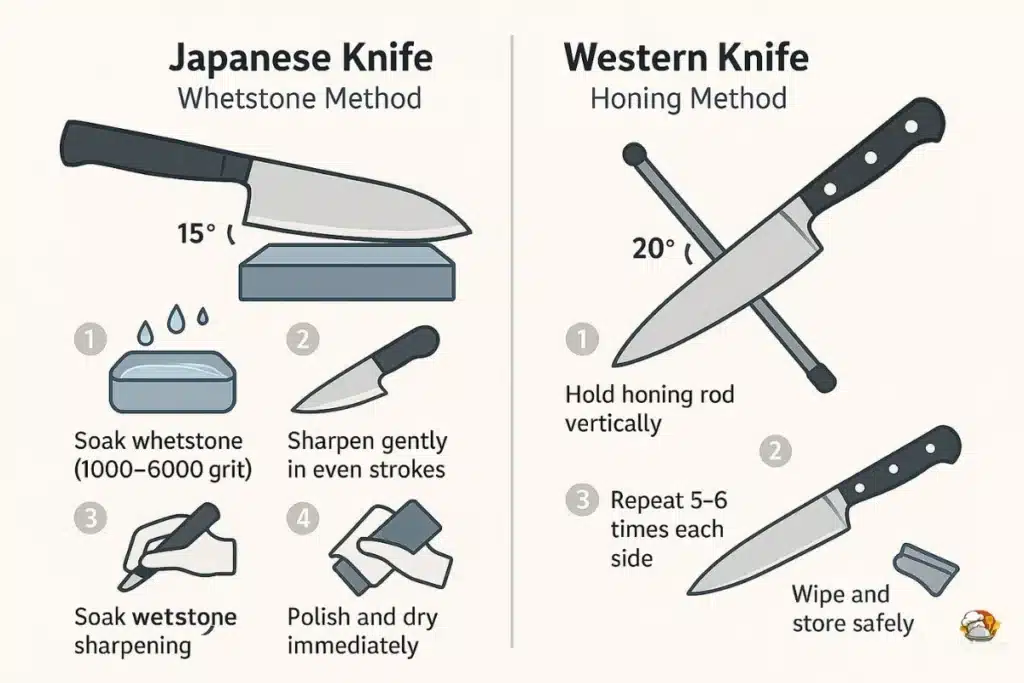
Japanese Knife Care
Known for their hard and sharp steel, Japanese knives require gentle, precise sharpening. Use a whetstone at about 15°, polish by hand, and always dry the blade immediately to prevent rust or micro-chipping.
Routine:
- Hone: After every 2–3 uses.
- Sharpen: Once a month with a 1000–6000 grit whetstone.
- Clean: Always hand-wash — never use a dishwasher.
Chef’s Tip: Recommended by professional chefs for maintaining razor-sharp edges and extending blade life.
Western Knife Care
Western knives are softer and thicker, which makes them easier to maintain.
Use a honing rod every few uses and sharpen around 20° when dull.They handle more pressure, perfect for everyday cooking in U.S. kitchens.
Routine:
- Hone: Every 3–4 uses.
- Sharpen: Every 2–3 months using a manual sharpener.
- Clean: Hand-wash and dry completely.
Recommended Tools: Honing rod, pull-through sharpener, or angle guide for easy upkeep.
The Culinary Institute of America shares best practices for knife sharpening and edge maintenance used by professional chefs across U.S. kitchens.
Quick Definition
Knife sharpening and maintenance mean caring for a knife’s edge and polish to keep it sharp, balanced, and long-lasting.
- Japanese knives use fine whetstones (≈15° angle).
- Western knives use honing rods and wider (≈20°) angles.
Maintenance Cycle (Comparison Table)
| Task | Japanese Knives | Western Knives |
| Sharpening Angle | ~15° | ~20° |
| Main Tool | Whetstone | Honing Rod / Manual Sharpener |
| Sharpening Frequency | Monthly | Every 2–3 months |
| Honing Frequency | Every 2–3 uses | Every 3–4 uses |
| Cleaning Method | Hand-wash only | Hand-wash only |
| Dishwasher Safe | ❌ No | ❌ No |
How Do Japanese and Western Knives Differ in Maintenance?
Japanese knives need more delicate sharpening because their steel is harder and edges are thinner. Western knives are easier to maintain, requiring less sharpening but frequent honing to stay aligned.
Keeping your knife sharp is just half the story. In the next part, we’ll see how both styles actually perform in real cooking situations.
Performance in Real Cooking
Knife performance in real cooking means how well a knife handles everyday kitchen tasks from slicing soft fish to cutting dense meat.Japanese knives focus on precision and control, while Western knives deliver power and durability.
Both perform well, but the right choice depends on your cooking style and the food you prepare most often.
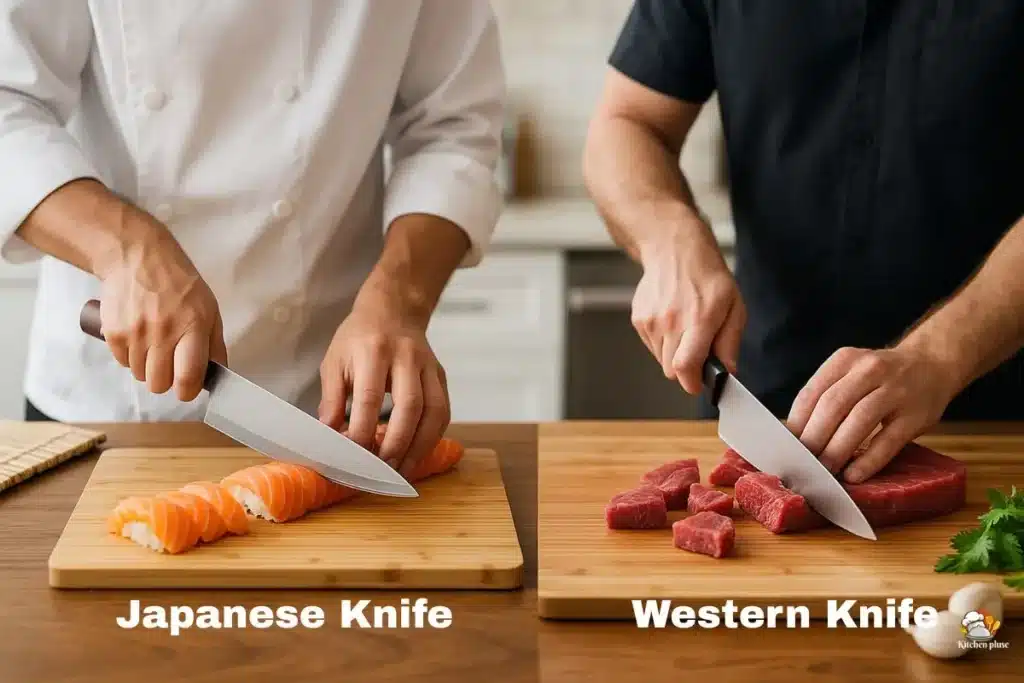
Japanese Knives in Real Cooking
Japanese knives are made for precision and finesse.Their thin, sharp edges (~15°) glide smoothly through ingredients, creating clean cuts without crushing food.This makes them perfect for dishes that demand detail, such as sushi, sashimi, and decorative vegetable cuts.See detailed picks in our guide on best knife for cutting vegetables.
Best For:
- Sushi & Fish Filleting → Gyuto, Yanagiba
- Vegetables & Herbs → Santoku, Nakiri
- Precision Cuts → Ideal for professional chefs and detail-oriented home cooks
Western Knives in Real Cooking
Western knives are built for strength and endurance. They have thicker blades (~20°) and full tang construction, providing stability and power. They’re perfect for U.S. kitchens, where home cooks prefer rock-cut motion for chopping, carving, and meal prep. Explore recommendations on the best knife for cutting meat.
Best For:
- Meat & Bones → Chef’s Knife, Boning Knife
- Dense Foods → Western Chef Knife (pumpkins, beef roasts)
- Everyday Use → Hybrid Santoku or Chef Knife
Quick Definition
Knife performance in real cooking means how effectively a knife cuts different foods in daily use.
Japanese knives are built for precision and thin slicing, while Western knives are made for power and heavy chopping.
Best Knife by Cooking Task (Comparison Table)
| Task | Best Choice | Reason |
| Sushi & Fish | Japanese (Gyuto, Yanagiba) | Thin, sharp edge for smooth slicing |
| Vegetables | Japanese (Santoku, Nakiri) | Flat edge, precise control |
| Meat & Bones | Western (Chef, Boning) | Heavy spine gives more force |
| All-Purpose Cooking | Hybrid (Santoku or Chef) | Balanced feel for versatile use |
Which Knife Performs Best in Real Cooking?
Japanese knives perform best for fine slicing and presentation, where accuracy matters most.
Western knives perform best for tough cuts and daily durability.For all-around performance, hybrid knives combine the strengths of both.
Once you know how they perform, the next logical step is comparing what they cost and which brands truly deliver value for U.S. buyers.
Price & Brand Comparison
Knife price and brand comparison shows how Japanese and Western knives differ in price, craftsmanship, and build quality.Japanese knives are hand-forged using premium steel, while Western knives are machine-made for durability, affordability, and easy maintenance.
Japanese Knife Brands
Japanese brands such as Shun, Miyabi, Global, Tojiro, and Dalstrong are admired for their artisanal craftsmanship and razor-sharp precision.Most Japanese knives cost between $120–$300, reflecting their VG10, AUS10, or Blue Steel composition and hand-polished finish. For in-depth comparisons and ratings, see our guide on best japanese knife brands.
Highlights:
- Shun – VG10 steel, handcrafted in Seki City; perfect for chefs who value sharpness and control.
- Miyabi – Damascus finish with elegant handles; a favorite among professionals.
- Global – Lightweight stainless steel with a seamless design; ideal for precision and hygiene.
- Dalstrong – Japanese-inspired hybrid design; mid-range, excellent for modern U.S. kitchens.
Why Japanese knives cost more: Each blade is individually forged by hand, taking 5–10 hours to craft, resulting in harder, sharper edges and longer edge retention.
See official specifications from Shun and Wüsthof to compare craftsmanship, steel quality, and balance directly from the manufacturers.
Western Knife Brands
Western knives like Wüsthof, Zwilling, Henckels, and Victorinox are made with X50CrMoV15 or 4116 German stainless steel, known for strength and easy maintenance. They usually range from $80–$250, making them popular in U.S. home kitchens for their practicality and balance. You can explore our detailed comparison of Best German Knife Brands.
Highlights:
- Wüsthof – Forged balance and heavy-duty durability for professional use.
- Zwilling – Hybrid performance; sharp yet strong for daily cooking.
- Henckels – Affordable, well-balanced knives for home chefs.
- Victorinox – Lightweight, low-cost, dishwasher-safe option for beginners.
Why Western knives cost less: They are machine-forged, allowing consistent production and lower labor costs—ideal for everyday users.
For verified brand details and product ranges, visit the official sites of Zwilling and Victorinox. These links provide genuine product data, ensuring readers get accurate information — not affiliate recommendations.
Quick Definition
Japanese knives cost more ($120–$300) because they are hand-forged from high-quality VG10 or AUS10 steel for superior edge retention.
Western knives cost less ($80–$250) because they are machine-made from softer German stainless steel, which is easier to maintain and repair.
Knife Brand Comparison Table
| Brand | Origin | Key Strength | Best for U.S. Buyer |
| Shun | Japan | VG10 steel, handcrafted | Home chefs wanting precision |
| Miyabi | Japan | Damascus pattern, artistic handle | Professional chefs |
| Wüsthof | Germany | Forged balance, durability | Heavy-use kitchens |
| Zwilling | Germany | Hybrid comfort, long lifespan | Everyday cooking |
| Victorinox | Switzerland | Budget-friendly, stainless steel | Beginners & students |
| Dalstrong | Japan-inspired | Modern hybrid steel | Affordable premium option |
Why Are Japanese Knives More Expensive Than Western Knives?
Japanese knives are handcrafted using harder, high-carbon steel, which gives sharper edges and better balance.
Western knives are mass-produced with softer steel, making them less costly and easier to maintain—perfect for U.S. home kitchens and everyday cooking.
Choosing the right knife isn’t just about price; it’s about fit. Up next, our buying guide will help you pick the perfect knife for your kitchen and skill level.
Buying Guide – Which Knife Suits You Best?
Choosing the right kitchen knife depends on your cooking style, skill level, and how often you cook. If you want expert-tested picks, see our updated guide on Best Kitchen Knives 2025. A good knife saves time, improves comfort, and keeps your hands safe — whether you’re slicing vegetables, trimming meat, or prepping for family dinners.
Quick Summary
- Japanese knives are made for precision and clean slicing.
- Western knives are built for strength and durability.
- Hybrid knives mix both — ideal for modern U.S. kitchens.
Knife Decision Matrix
| Cooking Style | Best Knife Type | Why It Fits | Example |
| Vegetarian Prep | Japanese (Gyuto / Nakiri) | Thin, sharp edge for smooth veggie cuts | Shun Classic 8″ Gyuto |
| Home Cook | Western (Chef’s Knife) | Durable, easy to sharpen, great all-rounder | Wüsthof Classic 8″ Chef Knife |
| Professional Chef | Hybrid (Santoku / Chef Knife) | Combines precision with power | Zwilling Pro 8″ Santoku |
Pro Tip for U.S. Buyers
Want both Japanese sharpness and Western balance?
Pick a Japanese-style Western hybrid knife — a popular choice in U.S. kitchens because it delivers precision cutting and easy maintenance in one blade.
How Do I Know Which Knife Type Is Right for Me?
- For vegetable cutting, choose a Japanese knife (Gyuto/Nakiri) for thin, clean slices.
- For everyday cooking, pick a Western chef knife — sturdy and long-lasting.
- For professional or frequent use, try a hybrid knife (Santoku/Chef) for perfect balance and comfort.
Quick Definition
The best knife for you depends on your cooking habits:
- Japanese knives → for precise, delicate work.
- Western knives → for power and daily use.
- Hybrid knives → for versatile cooking in U.S. homes.
Now that you’ve found your match, let’s wrap it all up — which knife philosophy truly wins in the kitchen battle of precision vs. power?
Japanese vs Western Knives – The Final Verdict
Japanese and Western knives show two sides of kitchen mastery — precision and power.
Neither style is better; both serve a purpose. If you’re choosing your first knife, explore our guide on Best Kitchen Knives to see which performs best.
- A Japanese knife gives balance, lightness, and surgical sharpness for detail work.
- A Western knife provides durability, weight, and control — perfect for everyday U.S. kitchens.
Together, they create the ideal toolkit for cooks who value both art and efficiency. To learn how materials affect sharpness, read knife materials and construction.
Quick Definition
Japanese knives focus on precision and clean slicing, while Western knives emphasize strength and versatility.Using both gives home cooks the best mix of control, balance, and long-term performance.
Pro Tip for U.S. Home Cooks
Keep one Japanese Santoku for fine cutting and one Western Chef’s Knife for tougher jobs. That pair combines samurai sharpness with German strength — ideal for modern American kitchens. For brand comparisons, check best kitchen knife brands.
Still unsure which knife to buy or how to care for it? Don’t worry the FAQ section below clears up the most common questions cooks ask.
Frequently Asked Questions About Japanese vs Western Knives
Are Japanese knives better than Western knives?
Japanese knives are sharper and lighter, made for precision slicing and detailed work. Western knives are heavier and stronger, better for everyday chopping and tough ingredients. Neither is strictly better — the right choice depends on your cooking style and comfort.
Why are Japanese knives so sharp?
Japanese knives use harder steel (like VG10 or AUS10) and are sharpened at a narrow 15° edge angle. This gives them razor-like sharpness for thin, clean cuts — perfect for sushi and vegetables. Learn how steel composition affects sharpness in knife materials and construction.
Why are Japanese knives more expensive?
Japanese knives are handcrafted using traditional forging methods and premium high-carbon steel. Each blade can take 5–10 hours to make, which adds to its precision, durability, and price.
Are Western knives good for everyday cooking?
Yes. Western knives, such as Wüsthof and Zwilling, are durable, balanced, and easy to maintain. Their double-bevel edge (~20°) makes them ideal for daily use in busy U.S. kitchens. See top recommendations in Best Kitchen Knives 2025
Do Japanese knives stay sharp longer?
Yes — the harder steel holds its edge longer than most Western knives. However, it also requires gentle care and hand washing to prevent chips or rust.
Which handle type is better — Japanese or Western?
Japanese Wa-handles are light, front-balanced, and perfect for precise cuts. Western handles have bolsters and a full tang for stability and safety. Choose the one that feels more natural in your hand. Find which fits your grip style best in Knife Handle Types.
Should I buy a Japanese or German knife?
If you value precision and clean slicing, choose a Japanese knife. If you prefer strength and easy maintenance, go with a German knife — ideal for most home cooks. Compare top brands in Best Japanese Knife Brands and Best German Knife Brands.
What’s the main difference in sharpening angles?
Japanese knives are sharpened around 15°, giving a sharper edge. Western knives use about 20°, which is stronger and more forgiving for tougher cuts. See proper techniques in Knife Sharpening and Maintenance.
Do professional chefs use Japanese knives?
Yes, many top chefs use Japanese knives for their fine balance and sharpness. Others prefer German knives for long kitchen hours and heavy prep — it’s all about personal preference.
What’s the best knife choice for beginners?
Start with one versatile knife — a Santoku (Japanese) or Chef’s Knife (Western).Both handle most kitchen tasks easily and give you a feel for your cutting style. Explore beginner-friendly picks in Best Kitchen Knives.
Why do Japanese knives chip easily?
Because they use harder steel and thinner edges, Japanese knives can chip if used on bones, frozen foods, or hard surfaces. Use them for soft ingredients and always hand wash and dry immediately.
Is German steel better than Japanese steel?
German steel is tougher and resists corrosion better. Japanese steel is harder, giving a sharper, longer-lasting edge. Each excels in its own way — one favors durability, the other precision.
What’s the best knife brand for U.S. home cooks?
- Shun – Sharp, handcrafted Japanese blades
- Wüsthof – Strong, well-balanced German knives
- Victorinox – Affordable and beginner-friendly option
Each offers quality depending on your budget and cooking needs.
Find more in Best Knife Brands.
Are hybrid knives worth it?
Yes. Modern hybrid knives combine Japanese sharpness with Western durability. They’re perfect for home cooks who want one knife that can do everything well.

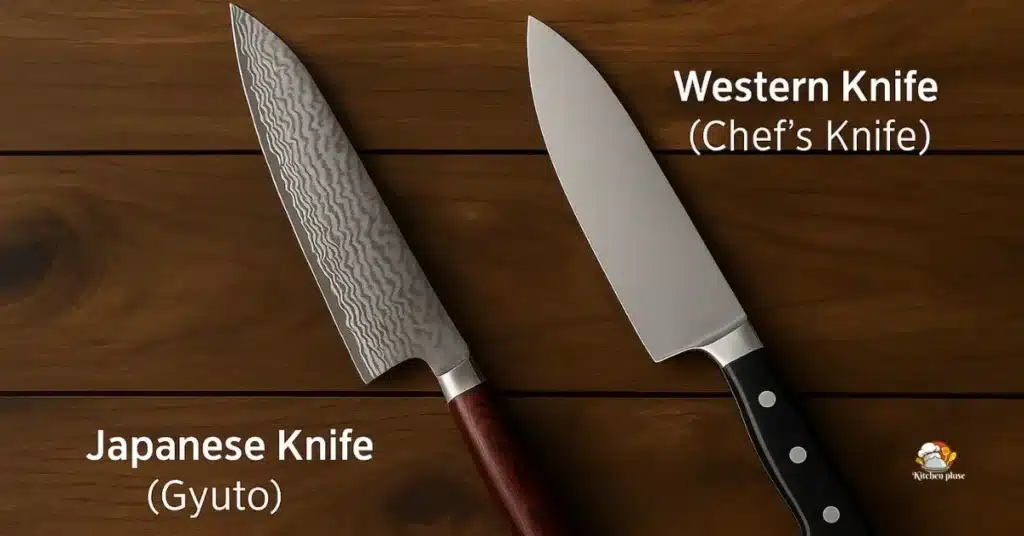
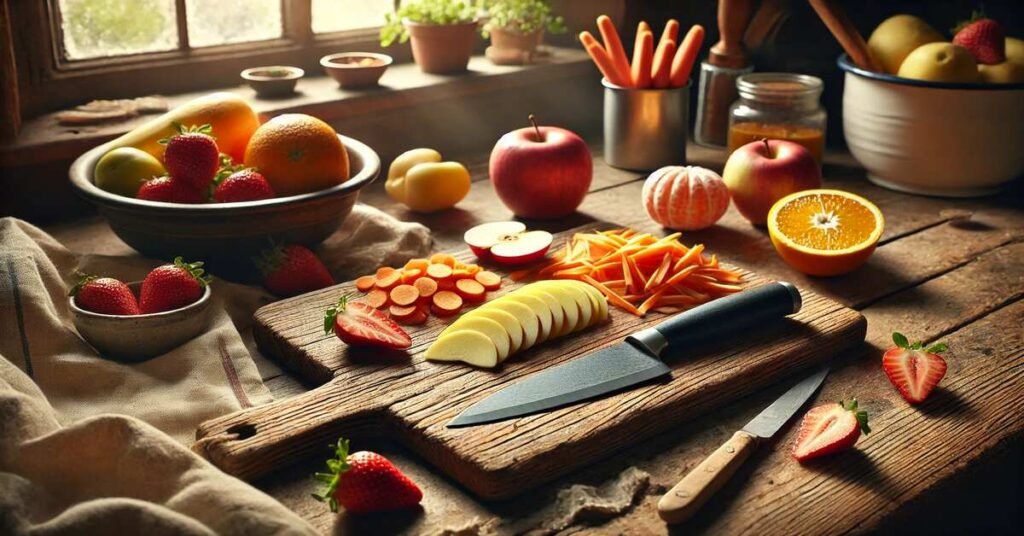
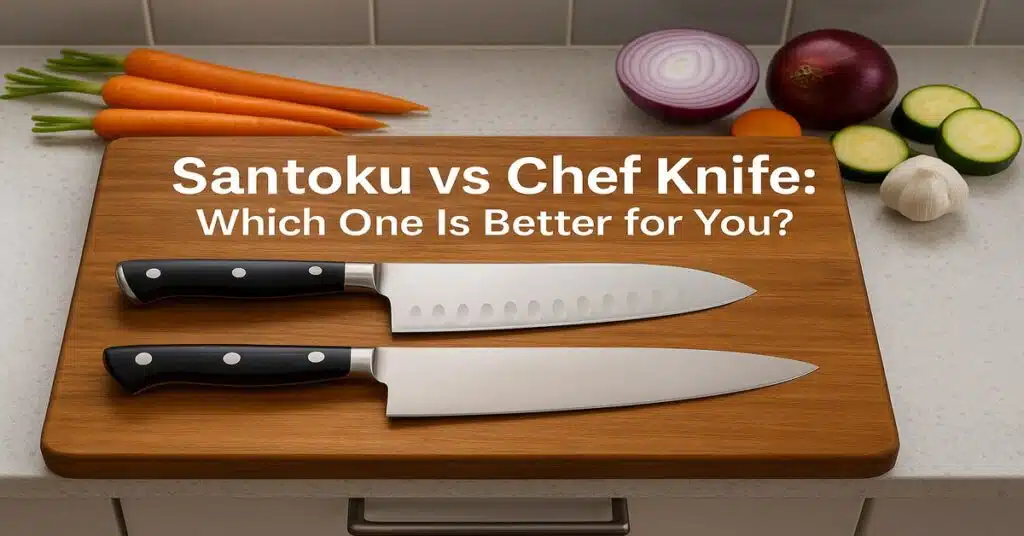
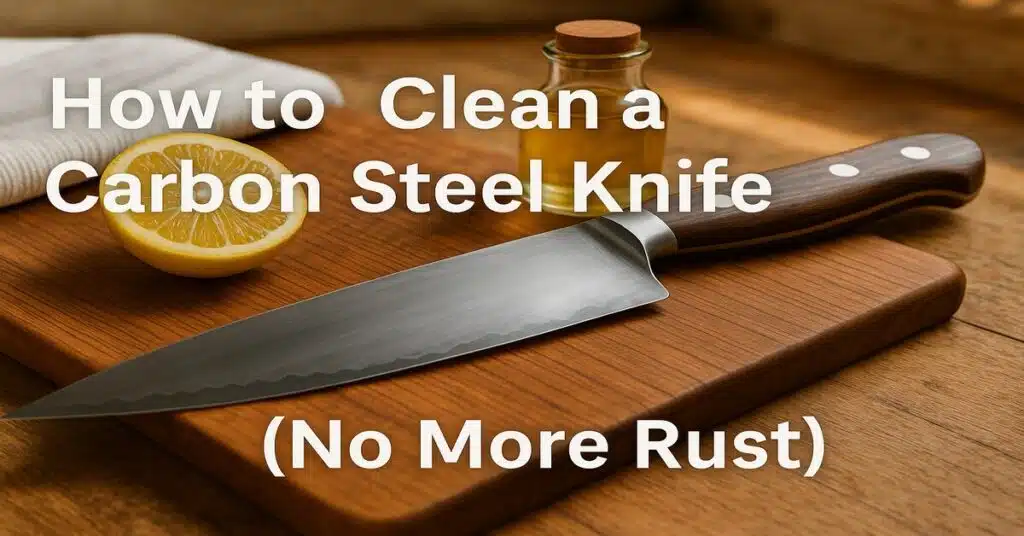

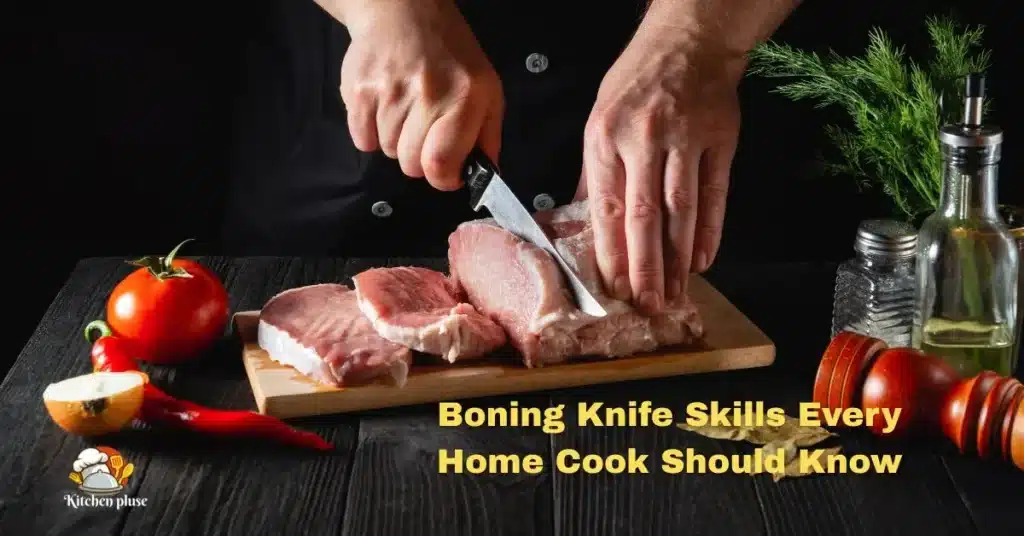
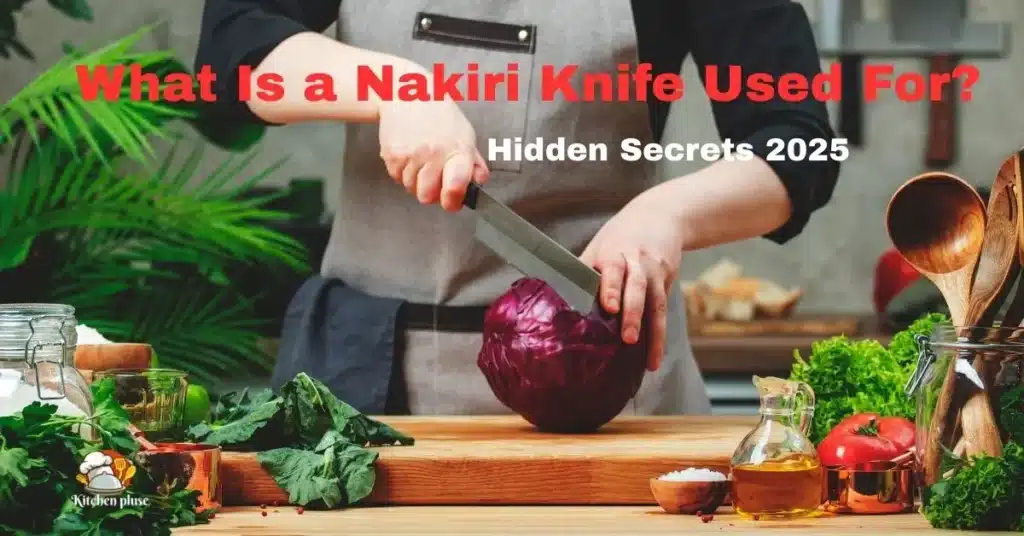
![7 Pro Tips How to Sharpen a Fillet Knife for Clean Cuts [2025]](https://kitchenpluse.com/wp-content/uploads/2025/09/7-Pro-Tips-How-to-Sharpen-a-Fillet-Knife-for-Clean-Cuts-2025-1024x536.webp)
